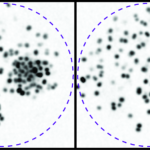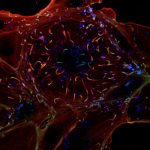About
Tens of thousands of biochemical reactions occur simultaneously in the cell. Small molecules are channeled through metabolic pathways at blistering speed. Giant complexes assemble to orchestrate transcription and translation. ATP fuels the active transport of organelles along microtubules, and actin networks drive membrane remodeling and agitate the cytoplasm. All of this occurs within a crowded cell interior that approaches the physical limits where jamming will occur. This extreme physical environment is both essential for life, and a potential liability. If cells become too dilute, they senesce and die. On the other hand, increased crowding eventually stalls growth. We found that the central growth regulator, mTORC1, is a crucial regulator of crowding. We also found that mechanical compression affects crowding and phase separation. We propose that perturbations to the physical properties of the cell interior through mechanical forces and the regulation of growth pathways play a crucial role in cell and developmental biology.
A talk from Liam Holt, from New York University Liam Holt: https://www.liamholtlab.org/
His main research articles:
– mTORC1 Controls Phase Separation and the Biophysical Properties of the Cytoplasm by Tuning Crowding. Cell. 2018 Jul 12;174(2):338-349.e20. doi: 10.1016/j.cell.2018.05.042. Delarue M(1), Brittingham GP(1), Pfeffer S(2), Surovtsev IV(3), Pinglay S(1),Kennedy KJ(4), Schaffer M(2), Gutierrez JI(4), Sang D(1), Poterewicz G(1), Chung JK(5), Plitzko JM(2), Groves JT(6), Jacobs-Wagner C(7), Engel BD(8), Holt LJ(9). Macromolecular crowding has a profound impact on reaction rates and the physical properties of the cell interior, but the mechanisms that regulate crowding arepoorly understood. We developed genetically encoded multimeric nanoparticles(GEMs) to dissect these mechanisms. GEMs are homomultimeric scaffolds fused to a fluorescent protein that self-assemble into bright, stable particles of definedsize and shape. By combining tracking of GEMs with genetic and pharmacologicalapproaches, we discovered that the mTORC1 pathway can modulate the effectivediffusion coefficient of particles ≥20 nm in diameter more than 2-fold by tuning ribosome concentration, without any discernable effect on the motion of molecules≤5 nm. This change in ribosome concentration affected phase separation bothin vitro and in vivo. Together, these results establish a role for mTORC1 incontrolling both the mesoscale biophysical properties of the cytoplasm andbiomolecular condensation.
– Ancestral resurrection reveals evolutionary mechanisms of kinase plasticity.. Elife. 2014 Oct 13;3. doi: 10.7554/eLife.04126.Howard CJ(1), Hanson-Smith V(2), Kennedy KJ(1), Miller CJ(3), Lou HJ(3), Johnson AD(2), Turk BE(3), Holt LJ(1). Protein kinases have evolved diverse specificities to enable cellular informationprocessing. To gain insight into the mechanisms underlying kinasediversification, we studied the CMGC protein kinases using ancestralreconstruction. Within this group, the cyclin dependent kinases (CDKs) andmitogen activated protein kinases (MAPKs) require proline at the +1 position oftheir substrates, while Ime2 prefers arginine. The resurrected common ancestor ofCDKs, MAPKs, and Ime2 could phosphorylate substrates with +1 proline or arginine,with preference for proline. This specificity changed to a strong preference for +1 arginine in the lineage leading to Ime2 via an intermediate with equalspecificity for proline and arginine. Mutant analysis revealed that a variableresidue within the kinase catalytic cleft, DFGx, modulates +1 specificity.Expansion of Ime2 kinase specificity by mutation of this residue did not causedominant deleterious effects in vivo. Tolerance of cells to new specificitieslikely enabled the evolutionary divergence of kinases.
– Global analysis of Cdk1 substrate phosphorylation sites provides insights intoevolution. Science. 2009 Sep 25;325(5948):1682-6. doi: 10.1126/science.1172867.Holt LJ(1), Tuch BB, Villén J, Johnson AD, Gygi SP, Morgan DO. To explore the mechanisms and evolution of cell-cycle control, we analyzed theposition and conservation of large numbers of phosphorylation sites for thecyclin-dependent kinase Cdk1 in the budding yeast Saccharomyces cerevisiae. Wecombined specific chemical inhibition of Cdk1 with quantitative mass spectrometryto identify the positions of 547 phosphorylation sites on 308 Cdk1 substrates in vivo. Comparisons of these substrates with orthologs throughout the ascomycetelineage revealed that the position of most phosphorylation sites is not conservedin evolution; instead, clusters of sites shift position in rapidly evolvingdisordered regions. We propose that the regulation of protein function byphosphorylation often depends on simple nonspecific mechanisms that disrupt orenhance protein-protein interactions. The gain or loss of phosphorylation sitesin rapidly evolving regions could facilitate the evolution of kinase-signalingcircuits.
– Positive feedback sharpens the anaphase switch.Nature. 2008 Jul 17;454(7202):353-7. doi: 10.1038/nature07050. Epub 2008 Jun 15.Holt LJ(1), Krutchinsky AN, Morgan DO. At the onset of anaphase, sister-chromatid cohesion is dissolved abruptly andirreversibly, ensuring that all chromosome pairs disjoin almost simultaneously.The regulatory mechanisms that generate this switch-like behaviour are unclear.Anaphase is initiated when a ubiquitin ligase, the anaphase-promoting complex(APC), triggers the destruction of securin, thereby allowing separase, aprotease, to disrupt sister-chromatid cohesion. Here we demonstrate that thecyclin-dependent kinase 1 (Cdk1)-dependent phosphorylation of securin near itsdestruction-box motif inhibits securin ubiquitination by the APC. The phosphataseCdc14 reverses securin phosphorylation, thereby increasing the rate of securinubiquitination. Because separase is known to activate Cdc14 (refs 5 and 6), ourresults support the existence of a positive feedback loop that increases theabruptness of anaphase. Consistent with this model, we show that mutations thatdisrupt securin phosphoregulation decrease the synchrony of chromosomesegregation. Our results also suggest that coupling securin degradation withchanges in Cdk1 and Cdc14 activities helps coordinate the initiation ofsister-chromatid separation with changes in spindle dynamics
– Evolution of Ime2 phosphorylation sites on Cdk1 substrates provides a mechanismto limit the effects of the phosphatase Cdc14 in meiosis. Mol Cell. 2007 Mar 9;25(5):689-702.Holt LJ(1), Hutti JE, Cantley LC, Morgan DO. Progression through meiosis in yeast is governed by the cyclin-dependent kinaseCdk1, in concert with a related kinase called Ime2. It remains unclear how these kinases collaborate to meet the unique demands of meiotic progression. Wedemonstrate that Ime2 and Cdk1 phosphorylate an overlapping substrate set andthat the two kinases overlap functionally as inhibitors of the ubiquitin ligaseAPC(Cdh1) and replication origin licensing. Surprisingly, Ime2 phosphorylatesCdk1 substrates at distinct phosphorylation sites that are highly resistant todephosphorylation by the phosphatase Cdc14. We propose that Ime2-dependentphosphorylation of a subset of cell-cycle proteins limits the effects of Cdc14 inmeiosis.


